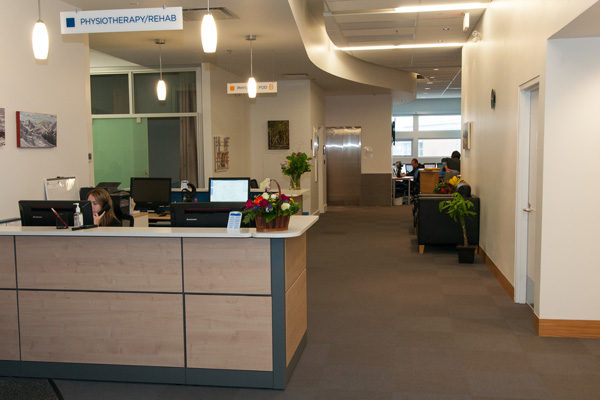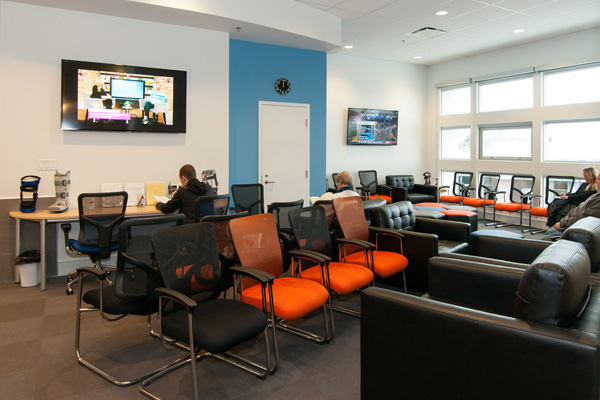EARLY PHASE
Nerve Transfer Surgery Resources
Triceps Branch to Axillary Nerve Transfer
- Donor
Triceps branch of radial nerve (innervates the posterior part of arm: lateral and medial heads of triceps and 12 posterior muscles of forearm aka the posterior compartment of the forearm) - Recipient
Axillary nerve (innervates the deltoid muscle and the teres minor muscle) - Purpose
To restore shoulder abduction, external rotation and stability
Table Slides
With your palm facing downwards, slide your hand forwards on a table, and actively extending your elbow (lean forward). This works to passively flex your shoulder while activating your donor muscles. After holding for a few seconds, return back to the starting position repeating 10-15 slides and repeat hourly.
Triceps Contraction
Attach one end of a light theraband to a door knob or railing. Facing whatever you attached the band to, hold the other end of the theraband in your affected hand with your arm in a flexed position. Work to contract your triceps by extending your arm as much as you can, pulling on the band. Release and return to the initial position. Repeat as directed.
MIDDLE PHASE (4 – 5 times per day)
Overhead Arm Lift
Lying on your front with your arms out in front of you, palms facing down. Contract your triceps muscle while attempting to lift your arm up off the bed. This works to contract your donor muscle (triceps) while focusing on contracting the recipient muscles (in the shoulder).
Prone Arm Abduction
Lying on your front with your arms by your sides, palms facing towards the ceiling. Contract your triceps muscle while attempting to lift your arm out to the side. This works to contract your donor muscle (triceps) while focusing on contracting the recipient muscles (in the shoulder).
Resisted Arm Abduction
Lie on your back with the unaffected arm close to the wall, palms facing down. Contract your triceps by extending your arms into the bed and attempt to lift both of your arms out to the side. Your unaffected arm will be resisted by the wall. Hold for a few seconds before releasing to start position. Repeat as directed.
LOADING
Shoulder AROM
Stand up straight with your arms by your sides. Lift up both arms to the side all the way above your head. Then slowly release them back to the initial position. Repeat as directed.
Resisted Arm Elevation
Step on one end of the theraband and hold the other end in your affected hand. Slowly raise your arm as high as you can and then slowly lower your arm in a controlled manner. Repeat as directed.
Resisted Arm Abduction
Step on one end of the theraband and hold the other end in your affected hand. Lift your arm out to the side as high as you can and slowly return to the initial position. Repeat as directed.
Double Fascicular Nerve Transfer
- Donor 1
Flexor digitorum superficialis (innervated BY muscular branches of the median nerve) - Recipient 1
Brachialis branch of musculocutaneous nerve (innervates the brachialis) - Donor 2
Flexor carpi ulnaris (innervated BY the ulnar nerve) - Recipient 2
Biceps branch of musculocutaneous nerve (innervates the biceps brachii) - Purpose
To help restore proper elbow flexion
EARLY PHASE
Active Fist Forming
Actively form a fist with the affected hand. Hold for a few seconds and then release. Repeat 10 to 20 times hourly.
Wrist Flexion and Extension
Flex and extend your wrists 10-20 times hourly.
Passive Elbow Flexion
Lie on your back, with your forearms facing the ceiling. Hold a dowel in both hands and flex both elbows.
Passive Elbow Flexion with Active Wrist Extension
Sit with your affected arm on the table. Make a fist while actively flexing your wrist and use your unaffected arm to passively flex your elbow. This activates your donor muscles while passively activating your recipient muscle.
MIDDLE PHASE
Assisted Elbow Flexion with Active Wrist Flexion
With your arm on a surface at shoulder level, actively flex your elbow while assisting flexion with your unaffected arm. Simultaneously flex your wrist and make a fist. Put a cloth under your forearm to reduce friction along the surface. Repeat as directed.
Isometric Holds in Different Ranges of Flexion
With your unaffected arm, position your affected arm in different ranges of flexion. Once in a position, hold a fist and try to maintain the position for about 5 seconds before releasing.
LOADING
Bicep Curls with Theraband
Step on the middle of a piece of theraband with one foot. Grab either ends of the band in each hand and flex your elbows to pull each hand towards your shoulders. Keep your back straight. Slowly let back down and repeat.
Anterior Interosseous Nerve to Ulnar Motor Nerve Transfer
- Donor
Pronator quadratus branch of AIN (innervates the pronator quadratus) - Recipient
Ulnar motor nerve (innervates flexor carpi ulnaris, flexor digitorum profundus, hypothenar muscles, third and fourth lumbricals, dorsal interossei, palmar interossei, adductor pollicis, flexor pollicis brevis and palmaris brevis) - Purpose
Prevent clawing and reconstruct the intrinsic hand muscles
EARLY PHASE
Passive Forearm Pronation
Bend your elbow at 90 degrees and hold a dowel with your palm facing up. Using your unaffected arm, use the dowel to passively rotate your arm at the elbow so that your palm faces downwards. Passively rotate your arm back to the starting position. Repeat 10-20 times hourly.
MIDDLE PHASE
Finger Abduction and Adduction
With your affected arm bent at 90 degrees and palm towards the ceiling, attempt to spread your fingers apart. Hold this position for a few seconds before releasing your fingers. Repeat as directed.
Active Forearm Pronation
Bend your elbow at 90 degrees with your palm facing up. Slowly rotate your arm at the elbow so that your palm faces downwards. Slowly rotate your arm back to the starting position and repeat this 10-20 times hourly.
Active Forearm Pronation with Finger Abduction
Rotate your forearm so that your palm faces the ground while simultaneously spreading your ring and pinky fingers apart. Repeat as directed.
LOADING
Resisted Forearm Pronation
Bend your affected arm at 90 degrees with your palm facing upwards. Hold one end of a theraband with your affected hand with the other end held in your unaffected hand. Slowly rotate your forearm so that your palm faces the floor. Slowly return to the starting position and repeat as directed.
Log Roll
Using resistance putty, rotate your arm to push your palm into the putty while simultaneously spreading your fingers. Focus on spreading the ring and pinky finger. Repeat as directed.
Log Chop
Roll the putty into a log and place it between two of your fingers. Pull those fingers together to compress the putty, making an indentation and then spread them apart as far as you can. Do this along the length of the log until it is all indented. After, reshape the putty into a log and place it between the next two fingers. Repeat this process between each of your fingers and as many times as directed.
Intrinsic Plus Card Draw
Pinch the putty with your four fingers together and thumb underneath. The motion should be performed as if you were picking up a singular piece of paper, focusing on pressing into the putty to extend the fingertips. Repeat as directed.
How can we help you?
Get in touch and let’s get started helping you feel better.
Call us at 250.940.4444
or email us at info@rebalancemd.com






